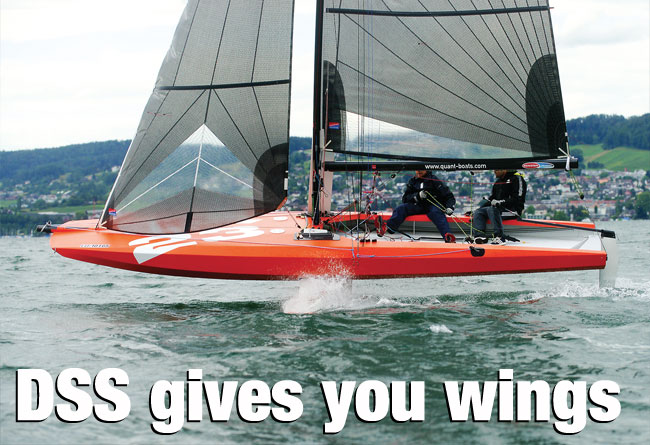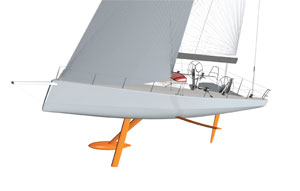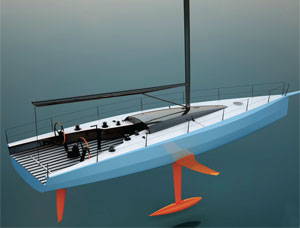

Hugh Welbourn and Infiniti Yachts’ Gordon Kay look at recent progress with Welbourn’s Dynamic Stability System
Infiniti 46R
With the sailing world going ‘foil-crazy’, stock prices are rising for Dynamic Stability Systems and Infiniti Yachts, one of the chief exponents of the patented DSS foil system. After all, why should multihulls and Moths have all the fun? Sticking a foil out down to leeward that generates lift and piles on righting moment when it is needed delivers one of the biggest performance enhancements you can make to your racing yacht. The point is finally sticking home, having morphed from a fringe eccentricity to a head-slapping ‘why didn’t we think of that years ago?’ And with his latest design, DSS creator Hugh Welbourn has proved it is now even possible to make a keelboat fly.
With the sailing world going ‘foil-crazy’, stock prices are rising for Dynamic Stability Systems and Infiniti Yachts, one of the chief exponents of the patented DSS foil system. After all, why should multihulls and Moths have all the fun? Sticking a foil out down to leeward that generates lift and piles on righting moment when it is needed delivers one of the biggest performance enhancements you can make to your racing yacht. The point is finally sticking home, having morphed from a fringe eccentricity to a head-slapping ‘why didn’t we think of that years ago?’ And with his latest design, DSS creator Hugh Welbourn has proved it is now even possible to make a keelboat fly.
Following on from the DSS-equipped Infiniti 36 performance daysailers, the first Infiniti 46R is currently midway through construction at Infiniti Yachts at the URSA Shipyard near Istanbul. Due for launch this September, the first 46R, designed by DSS creator Hugh Welbourn, has been developed as an offshore racing yacht for the classic 600-mile races such as the Rolex Sydney Hobart, Fastnet Race, Middle Sea Race and Newport-Bermuda. Hull no1, Maverick, will debut this November on the RORC Transatlantic race. The boat has been engineered by Gurit to withstand the rough conditions these races can deliver and is built using Gurit pre-preg carbon fibre with an M-Foam core.
In line with many owners’ wishes, the Infiniti 46R has been designed to be sailed relatively shorthanded with a crew of just six and is fitted with a canting keel to provide added power upwind to compensate. The keel is canted with a single Cariboni hydraulic ram while a single canard forward minimises leeway.
 Above: the new Infiniti 53 by Farr signifies a major endorsement of DSS from one of the world’s most respected design offices. While the smaller Infiniti 46 (below) features a pair of retracting foils the larger 53 utilises a single foil that slides across the boat
Above: the new Infiniti 53 by Farr signifies a major endorsement of DSS from one of the world’s most respected design offices. While the smaller Infiniti 46 (below) features a pair of retracting foils the larger 53 utilises a single foil that slides across the boat
Fitting DSS requires a reappraisal of where a yacht can get righting moment. If a larger proportion of this is taken by the DSS foil, then it means a smaller bulb can be fitted and there is less requirement for hull form stability through large beam and full sections. Designed correctly, this leads to improved all-round performance – the faster the DSS foil passes through the water the more stability it provides; while in light conditions, the foil retracts completely, leaving a light, easily driven hull. In the case of the Infiniti 46R, there is a chine running the length of the hull and a hull-deck chamfer to further reduce weight and windage.
Unlike the Infiniti 36, which features a single DSS foil that slides laterally through the hull in a tack, the larger boat features twin curved boards that retract into cases located in the forepeak. For practical purposes, this allows the new leeward foil to be deployed going into a tack or gybe, meaning dynamic stability is ready and waiting on the new course.
In terms of rig and deck layout, the 46R has undergone an exhaustive refinement process and is equipped with ultra-lightweight and simple solutions throughout. The mast is built in ultra-high modulus carbon fibre by Axxon Composites with composite standing rigging and topmast backstays, all lashed to the rig as per the latest Imoca 60s. Harken Grand Prix gear is fitted throughout as standard, including a single Carbon Air pedestal. A Cariboni hydraulic package drives the canting keel and other functions. All rams are in titanium, as are most fastenings as well as the propeller shaft in the tidy retractable propulsion system.
The Infiniti 46R is available with either fixed keel or a canting keel/single canard options, depending on owner preference.
Farr Yacht Design Infiniti 53
The latest naval architects to adopt DSS are Annapolis-based Farr Yacht Design, their first use of the system being in Infiniti Yachts’ new 53ft Farr-designed raceboat.
According to Farr vice-president Britton Ward, Farr Yacht Design are considering DSS for the latest generation of Imoca 60s as a means of improving stability now that keels and rigs are onedesign, adding that, ‘It was abundantly clear to me that Dynamic Stability Systems could play a really big part in that arena.
‘For a long time we have been using inclined keel pins and anhedral daggerboard incline angles in our designs to give a big performance boost. The logical extension is DSS and we certainly saw some large performance potential there, so it seemed sensible to work with the guys who have been doing it for 12 years.’
Ward believes that DSS will be a key component of future monohull design. ‘Gordon [Kay of Infiniti Yachts] and Hugh [Welbourn] have done an awful lot of homework. We want to be on the cutting edge with what we offer our clients as design solutions so it makes a great deal of sense for us to partner with them. Five years ago DSS was considered pretty revolutionary and on the fringe. Now it seems quite logical.’
The Infiniti 53 came about because the Farr office had been looking at a replacement for the canting-keel Cookson 50. ‘That’s been winning everything under IRC, particularly if the conditions are right. As we started looking into that, DSS was coming along. We started evaluating that and it became clear that it could be a really good thing,’ Ward said.
In terms of the performance benefits of a DSS-equipped yacht of this size over one without DSS, Ward says it amounts to knots at reaching angles. ‘It can be a 15-20 per cent boat speed increase and at reduced heel angles too. It makes the boat substantially more forgiving. The primary benefit is that the boat just gets faster and faster as wind speed goes up. Upwind it has some significant advantages in terms of motion while keeping the boat more stable, so you get an improvement there too.’
Ward observes that many boats are now being fitted with DSS foils or similar, but few to date other than the Welbourn designs and now Farr’s Infiniti 53 have been designed with the DSS foil as a starting point.
In terms of how he sees the DSS foil affecting hull shape, Ward says: ‘I think because you’re sailing at a substantially lower heel angle, it significantly alters the shape of the boat and how it dynamically trims. You don’t want it to trip over itself as it rises up on the foil. It has to be well behaved, so there are lots of things to be understood there. Then it gets coupled with canting keels and centreline daggerboards. There is a lot of optimisation to be done to see how all those things work together, but that’s exciting from a design perspective.’
The Infiniti 53 will differ from the 46R in that it will be designed for a ‘full’ crew. As with the 46R, the appendage configuration is likely to remain flexible, so it can be tailored to the owner’s requirements. But the base set-up is likely to include a single rudder and a gybing canard (like the Cookson 50). Instead of twin DSS foils, the 53 will revert to the single foil set-up, similar to the Infiniti 36. ‘If you are trying to keep costs down, this is probably the right solution,’ says Ward, who adds that the boat will cost significantly less than a new TP52.
As with the 46R, the strength of the 53 will be more coastal and offshore racing rather than windward-leewards. Her length has been deliberately chosen to get away from the glut of 52-footers, such as the prolific TP52s. The hull will carry a full chine, like the 46R, and is also likely to feature the modern-day Farr trademark of a slightly reverse sheer to the bow. Construction will start this autumn.
Quant 23
The latest development with DSS is the Quant 23, believed to be the world’s first fully foiling keelboat. It is another Hugh Welbourn design, built by Paul Jennings’ company Projects by Design in Cowes. The 23 follows on from the DSS-equipped Quant 28 prototype and Quant 30 production boats, both developed and marketed by Swiss company Quant Boats.
| The Dynamic Stability System Invented by British designer Hugh Welbourn and in development for the past 12 years, DSS can dramatically boost the performance of a monohull by increasing righting moment. It comprises a retractable foil, deployed laterally to leeward, where its passage through the water generates vertical lift. Importantly, this added righting moment is ‘dynamic’ – the faster a boat goes, the more lift and thus stability the foil creates. Conversely, in light conditions, when no additional stability is required, the foil is retracted completely to minimise drag. Significantly, while the lifting foils on foiling catamarans and Moths require constant trimming – either manually controlled or automatically via a wand and trim tab on the Moth – DSS does not. This is possible due to many factors, such as the length of the foil, its varying section and curvature over its length, its position in the boat, and so on. Dynamic Stability System foils come in a variety of arrangements, from a single board that runs laterally through the boat (as proposed for the Infiniti 53) to twin boards that are either like horizontal centreboards, able to flip out or in, or twin curved boards that retract into cases within the forepeak, like the Infiniti 46R. |
To enable it to fly, the Quant 23 features key modifications over its non-flying predecessors. Most significant are its foil developments: it features an inverted T-foil rudder and what at first glance appears to be a significantly different main lifting foil, with a giant bend in it. Unlike other DSS foils to date that exit through the topsides close to the waterline while at rest, the new foil is top-loaded like a conventional daggerboard. The 23 foil drops down rather than flipping out, but thanks to the ‘bend’ in it, as the board is lowered its tip is forced into a horizontal orientation similar to a conventional DSS board.
At this point in the board’s lowering, the Quant 23 can be used as a regular non-flying DSS design. However, if the boards are dropped a further foot or so, the 23 can get fully airborne as she demonstrated most satisfyingly on her maiden voyage in Cowes.
The Quant 23 differs from most fully foiling boats in that she has been designed to fly without demanding any great skill or exertion on the part of the crew. As Quant Boats’ Michi Aeppli said, ‘The aim was not to create the world’s fastest foiler, but one of the easiest crafts to fly steadily, providing fun and fast rides in a range of conditions. For us this means that the boat will do 90 per cent of the work and not the crew, which seems the converse to many other modern foilers with complicated systems to manage and maintain.’
| Infiniti 46R | Infiniti 53 by Farr | |
| LOA | 14.1m | 16.15m |
| LWL | 13.9m | 15.25m |
| Beam | 3.9m | 4.4m |
| DSPL | 5,400kg | 7,450kg |
| Draft | 3.0m | 3.65m |
| Bulb weight | 2,200kg | 3,400kg |
| Max cant angle | 35 degrees | 35 degrees |
Hugh Welbourn agrees that the ‘gentleman’s foiler’ is an apt description of the Quant 23, as it requires no active rake control on its foils (though this can be altered on the main foil and rudder by up to 5°) and no fore and aft trimming of the boat via crew weight. This is possible through a combination of many factors, such as the changing section of the DSS foil, its curve, length and positioning in the boat. Ride height, for example, auto-corrects due to the foil gradually emerging from the water the faster the boat goes, shedding lift in the process. But the point of sail and heel of the boat determine whether this lift is shed from the inboard or outboard end of the foil.
Only after you’ve recovered from seeing the 23 fly do you also notice the radical boat that the foils are attached to. This is best described as a 21st-century scow – futuristic looking with an ultra-low freeboard, a full-length chine and hull-deck chamfer.
Hugh Welbourn explains why he has taken this path: ‘If you’re trying to get a quick base hull out of something that requires a certain amount of righting moment, with the scow hull as your starting point you’ve immediately got a stable platform that you can push along nicely with just a couple of people on the rail, because you’ve got this nice wide beam. Then, when you want to stick the foil out, you’ve got a wide base span from which to increase your righting moment for when you want to get flying.’
The first Quant 23 is currently undergoing sailing trials in Switzerland prior to going into production. The 23 is already demonstrating impressive performance, getting up on its foils in 8kt of wind and managing 16-18kt in 10kt. It will even foil upwind in around 8-10kt of breeze. And it is still early days…
Click here for more information on Infiniti Yachts»
We invite you to read on and find out for yourself why Seahorse is the most highly-rated source in the world for anyone who is serious about their racing.
To read on simply SIGN up NOW
Take advantage of our very best subscription offer or order a single copy of this issue of Seahorse.
Online at:
www.seahorse.co.uk/shop and use the code TECH20
Or for iPad simply download the Seahorse App at the iTunes store


